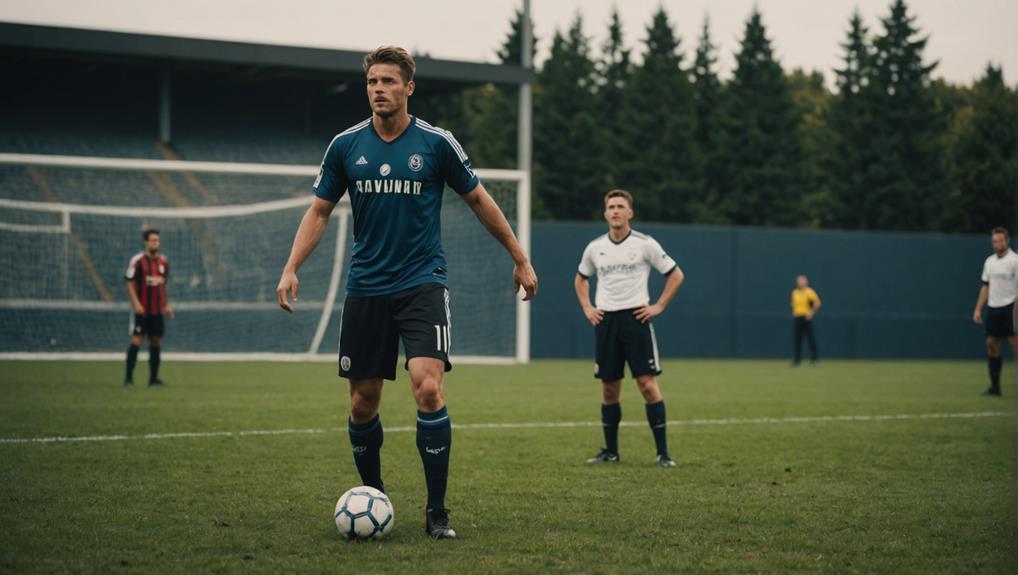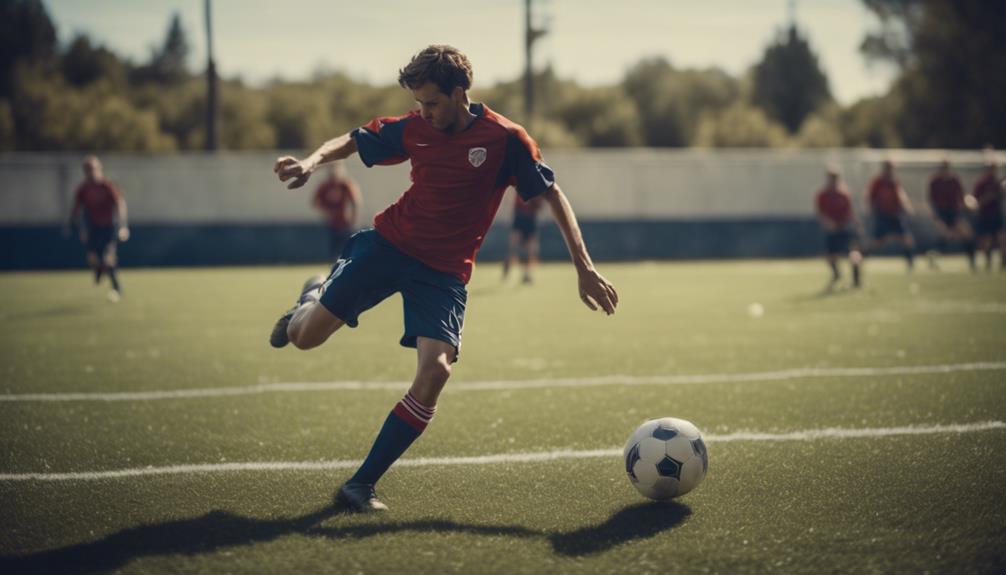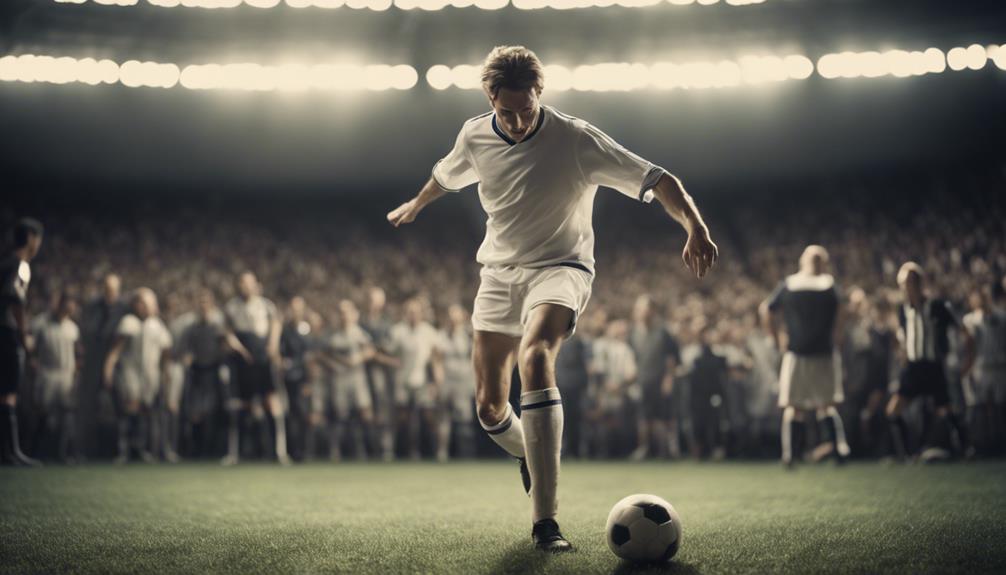
Understanding Throw-In Rules in Soccer
July 2, 2024To succeed in soccer, remember these throw-in rules. When the ball travels over the touchline, a throw-in is granted. Your position must be facing the field with both feet outside the line. Keep opponents two meters away during the throw. The ball should be thrown overhead with both hands. Make sure it enters the field before touching the ground. By following these rules, you guarantee a fair game for all. More insights into player positioning and restrictions can help you master throw-ins in soccer.
Throw-In Occurrence and Location
Understanding when and where throw-ins occur is essential for players to uphold possession and guarantee fair play in soccer matches. A throw-in is awarded when the ball crosses the touchline, which is the boundary line running the length of the field. This rule guarantees a fair restart position for the opposing team.
Opponents must maintain a distance of at least 2 meters during a throw-in to prevent interference and maintain the integrity of the game.
To execute a proper throw-in, the player must stand facing the field, making sure both feet are on or outside the touchline. This position not only complies with the rules but also allows for a successful throw-in that retains possession for your team.
Player Positioning and Technique
To successfully execute a throw-in in soccer, players must maintain proper positioning and utilize the correct technique. Player positioning is essential, requiring both feet to remain on or behind the touchline. The ball must be thrown from behind and over the head using both hands for a legal throw.
It's vital for the thrower to face the field of play during the throw-in to guarantee fair play. Once the ball enters the field before touching the ground, play resumes. Opponents must maintain a distance of at least two yards from the thrower to uphold the throw-in rules and prevent interference.
Adhering to these guidelines is important for the proper execution of a throw-in, promoting fair play and maintaining the integrity of the game. Remember, following these rules will help you deliver a legal throw and contribute effectively to your team's performance.
Ball Handling and Release

Proper ball handling and release technique during a throw-in in soccer is essential for maintaining fairness and executing a legal throw. When performing a throw-in, remember to use both hands to throw the ball from behind and over your head. This standardized method guarantees that the throw is legal and follows the rules set in place.
By adhering to proper ball handling and release procedures, you can prevent foul throws and uphold the integrity of the game. Keeping both feet on the ground during the throw-in is important to avoid gaining an unfair advantage over the opponent.
Understanding the importance of following the specific rules for ball handling and release in soccer throw-ins is crucial for all involved in the game. Practicing these techniques won't only benefit your team but also contribute to a more enjoyable and fairly played match.
Opposing Team Distance Requirement
Maintaining a distance of at least 2 meters from opposing players is a vital requirement during soccer throw-ins to guarantee fair play and prevent interference with the throw. By standing 2 meters away, opposing team members ensure that the thrower has ample space to execute the throw-in without any hindrance. This distance rule is in place to prevent any attempts to obstruct or influence the throw unfairly.
Violating this requirement can lead to cautions or even result in free kicks being awarded to the opposing team. Upholding the 2-meter distance rule during throw-ins is essential for maintaining the integrity of the game and ensuring a fair restart of play. It not only promotes sportsmanship but also helps in avoiding unnecessary disruptions that could impact the flow of the match.
Player Restrictions and Violations

Adhering to specific player restrictions and avoiding common violations is vital during soccer throw-ins to guarantee fair play and rule compliance. Players must make sure both feet remain on or outside the touchline when executing a throw-in to prevent violations.
Using only one hand to throw the ball, stepping onto the field, or performing running or jumping throws are considered violations. Touching the ball again before another player does results in the opposing team being awarded an indirect free kick.
To maintain fairness, opponents must keep a distance of at least 2 meters during the throw-in to avoid interference. It's important to refrain from deliberately throwing the ball at an opponent, as play will continue without a foul being called.
Additional Throw-In Regulations
To further enhance your understanding of throw-in rules in soccer, let's now explore some additional regulations that govern this aspect of the game.
When taking a throw-in, opponents must maintain a distance of at least 2 meters to uphold fair play. Any delays in restarting play from a throw-in can result in cautions being issued to players to keep the game flowing smoothly.
Committing a foul throw, such as not using both hands or lifting a foot, will result in a throw-in being awarded to the opposing team. Additionally, touching the ball a second time before another player does leads to an indirect free kick for the opponents. It's important to ensure proper execution of throw-ins to avoid these consequences.
Moreover, if a goalkeeper handles a ball thrown by a teammate during a throw-in, it results in a free kick being awarded to the opposing team. Understanding and adhering to these additional regulations surrounding throw-ins is essential for maintaining the integrity and fairness of the game.
Conclusion
So next time you're on the sidelines watching a soccer match, keep an eye out for those throw-ins! They might seem simple, but they can make a big impact on the game.
Just like a well-thrown pass can change the course of a match, a perfectly executed throw-in can shift the momentum in an instant.
Pay attention to the rules and techniques, and you'll have a whole new appreciation for this often overlooked aspect of the game.


